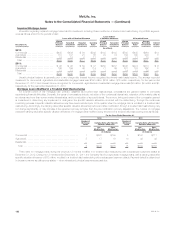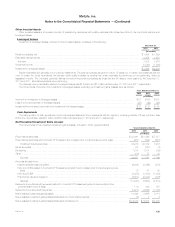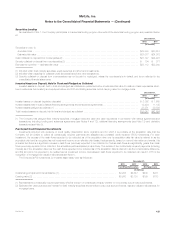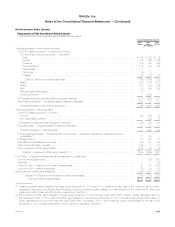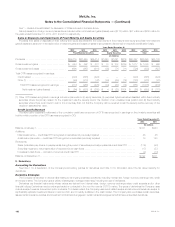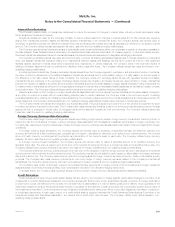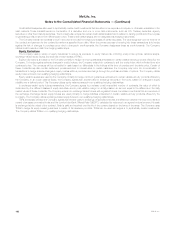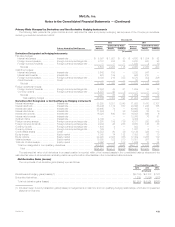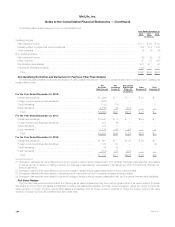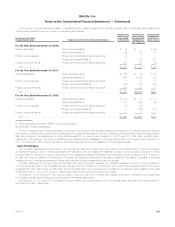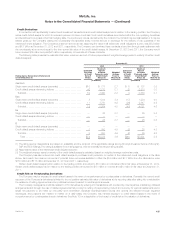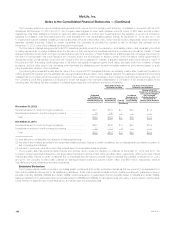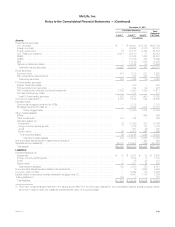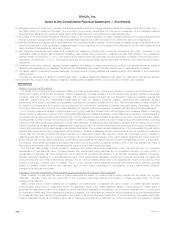MetLife 2012 Annual Report Download - page 138
Download and view the complete annual report
Please find page 138 of the 2012 MetLife annual report below. You can navigate through the pages in the report by either clicking on the pages listed below, or by using the keyword search tool below to find specific information within the annual report.
MetLife, Inc.
Notes to the Consolidated Financial Statements — (Continued)
Credit default swaps are also used to synthetically create credit investments that are either more expensive to acquire or otherwise unavailable in the
cash markets. These transactions are a combination of a derivative and one or more cash instruments, such as U.S. Treasury securities, agency
securities or other fixed maturity securities. The Company also enters into certain credit default swaps held in relation to trading portfolios for the purpose
of generating profits on short-term differences in price. These credit default swaps are not designated as hedging instruments.
The Company enters into forwards to lock in the price to be paid for forward purchases of certain securities. The price is agreed upon at the time of
the contract and payment for the contract is made at a specified future date. When the primary purpose of entering into these transactions is to hedge
against the risk of changes in purchase price due to changes in credit spreads, the Company designates these as credit forwards. The Company
utilizes credit forwards in cash flow hedging relationships.
Equity Derivatives
The Company uses a variety of equity derivatives to reduce its exposure to equity market risk, including equity index options, variance swaps,
exchange-traded equity futures and total rate of return swaps (“TRRs”).
Equity index options are used by the Company primarily to hedge minimum guarantees embedded in certain variable annuity products offered by the
Company. To hedge against adverse changes in equity indices, the Company enters into contracts to sell the equity index within a limited time at a
contracted price. The contracts will be net settled in cash based on differentials in the indices at the time of exercise and the strike price. Certain of
these contracts may also contain settlement provisions linked to interest rates. In certain instances, the Company may enter into a combination of
transactions to hedge adverse changes in equity indices within a pre-determined range through the purchase and sale of options. The Company utilizes
equity index options in non-qualifying hedging relationships.
Equity variance swaps are used by the Company primarily to hedge minimum guarantees embedded in certain variable annuity products offered by
the Company. In an equity variance swap, the Company agrees with another party to exchange amounts in the future, based on changes in equity
volatility over a defined period. The Company utilizes equity variance swaps in non-qualifying hedging relationships.
In exchange-traded equity futures transactions, the Company agrees to purchase or sell a specified number of contracts, the value of which is
determined by the different classes of equity securities, and to post variation margin on a daily basis in an amount equal to the difference in the daily
market values of those contracts. The Company enters into exchange-traded futures with regulated futures commission merchants that are members of
the exchange. Exchange-traded equity futures are used primarily to hedge liabilities embedded in certain variable annuity products offered by the
Company. The Company utilizes exchange-traded equity futures in non-qualifying hedging relationships.
TRRs are swaps whereby the Company agrees with another party to exchange, at specified intervals, the difference between the economic risk and
reward of an asset or a market index and the London Inter-Bank Offered Rate (“LIBOR”), calculated by reference to an agreed notional amount. No cash
is exchanged at the outset of the contract. Cash is paid and received over the life of the contract based on the terms of the swap. The Company uses
TRRs to hedge its equity market guarantees in certain of its insurance products. TRRs can be used as hedges or to synthetically create investments.
The Company utilizes TRRs in non-qualifying hedging relationships.
132 MetLife, Inc.


